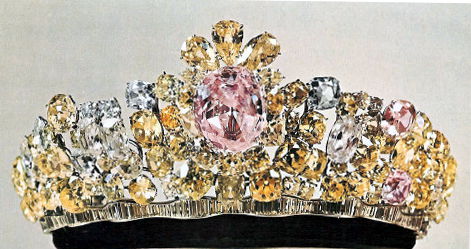Noor-ul-Ain Diamond Tiara
- Home /
- Famous Diamonds /
- Noor-ul-Ain Diamond Tiara
For centuries, royalty have adorned themselves with jewels to display their superior wealth. They wear pendants crafted with the finest gems and carry staffs embedded with precious stones from distant lands. One of the most popular methods of showcasing the shimmering pieces in a royal collection is to craft them into stunning tiaras. In 1958, Empress Farah Diba received one of the world's most breathtaking tiaras, the Noor-ul-Ain Diamond Tiara, when she married Mohammad Reza Shah Pahlavi, the last shah of Iran.
 Noor-ul-Ain Diamond Tiara
Noor-ul-Ain Diamond Tiara
The History of the Noor-ul-Ain Diamond
Most likely originating from the Kuller mines in Southern India, the Noor-ul-Ain is one of the most impressive stones in the world. Many believe it was once part of a larger diamond 400-carat diamond called the Great Table diamond that was split into two gems we now know as the Darya-ye-Noor and the Noor-ul-Ain.
After Nadir Shah and his army overtook Dehli in 1739, the diamond was among the items ransacked. It left India with the Shah and became part of the Iranian crown jewels in 1739. The Noor-ul-Ain changed hands several times as assassinations and military coups caused shifts in power. In 1921, after democracy failed and the British and Russians left Iran, an Iranian officer of the Persian brigade called Reza Khan crowned himself Shah.
However, Reza Khan aligned Iran with the Nazis during World War II, and eventually the Allied Forces made him abdicate his throne to his son, Mohammed Reza Pahlavi. The crown jewels and royal wealth went to the young man, and when he married the Empress, he had Harry Winston craft the Noor-ul-Ain Diamond into the beautiful diamond tiara we recognize today.
The Noor-ul-Ain diamond and its tiara setting are still part of the Iranian Crown Jewels, a collection of the world's most impressive gems.
What Makes the Noor-ul-Ain Tiara Special?
In Persian and Arabic, Noor-ul-Ain means "light of the eye," and the diamond certainly lives up to the name. This precious stone weighs 60 carats, making it one of the largest colored diamonds in the world.
The Noor-ul-Ain is a pink diamond which means that it is part of a group of gems that only accounts for .0001 percent of the world's precious stones. On top of that, it was classified as a type IIa diamond which is the rarest type of diamonds - which accounts for diamonds such as the Hope Diamond.
The Noor-ul-Ain Diamond is the centerpiece of Empress Farah's tiara, and it shines beautifully. Surrounding the Noor-ul-Ain are 324 other pink, yellow and colorless baguett-cut diamonds, many of which ranging from 14 to 19 carats each!
Diamonds have long been associated with royalty, and diamond-studded tiaras were often used as settings for the most important gems. However, no crown can quite compare with the Noor-ul-Ain diamond tiara. Its storied past and incomparable quality set it apart from others. This tiara is already unforgettable with the Noor-ul-Ain, one of the largest pink diamonds in the world, at its center. Yet, the accompanying stones and platinum setting cement its reputation as one of the finest pieces in history. Large, beautiful stones often leave us wondering if there are colored diamonds even larger than the Noor-ul-Ain that have yet to be discovered.
